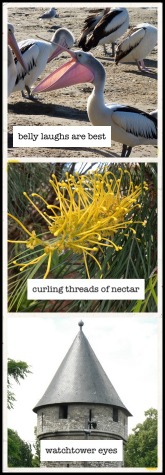Using Technology for Poetry Creation and Presentation with Kids
by Susan Stephenson, http://www.thebookchook.com/
Technology is inherently motivating for children. So too is poetry. Combining them packs a powerful punch, and is a great source of creative expression for kids. Here are some tips for using apps and other digital tools so children can create and present poetry.
A browser and search engine like Google will suggest lots of poetry sources. These make great text and auditory models for kids. Check out publishers you like for books of poetry for kids, or read aloud poems you find on poets’ websites. Even something as simple as a webpage of nursery rhymes can be great fodder for young poets. You can follow this up by helping children follow the rhythm but change the words, or just change the rhyming words. Reading lots and lots of great poetry is the very best background for young poets.
Take kids on a photo walk and have them capture images with a camera, whether a traditional one or part of an iDevice. Help children add the text they want to an image using a photo editor online, or a text-adding app like Phonto. The resulting images can be printed out or kept as a digital portfolio. This works beautifully with haiga, the art of creating with haiku and an image. You can see an example of haiga above.
Poets play with words, so I love to find ways to encourage that play. Tapping, walking, clapping a beat or chanting a rhyme with lots of zany expressions can make great material for a family video. Most phones and tablets nowadays enable video recording, and it’s quick and easy. Stitch video clips together with editors like Windows Movie Maker or iMove. The website Perform a Poem http://performapoem.lgfl.org.uk/ has tips on recording children’s performances with a video camera.
PicLits http://www.piclits.com/compose_dragdrop.aspx is a wonderful online space where kids can combine words with images too. They can choose from a supplied list of nouns, verbs, adjectives etc and drag them onto their chosen image, or try freestyle where they type in the words they want. You can see an example of PicLits below.
The Read Write Think app, Word Mover, encourages children to create poetry with word magnets. http://www.thebookchook.com/2013/06/creative-ipad-apps-for-kids-word-mover.html There’s an Android version and an iOS version, http://www.readwritethink.org/classroom-resources/mobile-apps/word-mover-30930.html and children can also make poems on the website http://www.readwritethink.org/classroom-resources/student-interactives/word-mover-b-30964.html itself.
Mobile technology means that children can use phones and tablets to record their poems orally too. This is handy if kids are desperate to save their inspiration when out and about. But it’s also a useful idea to have children record reading a poem aloud so they can listen to themselves. An app that facilitates this for iPad is Shadow Puppet, where kids record over their chosen photos, but any voice recorder can work. Children can also try Dragon Dictation, a voice recorder that types what you say.
Another great app that encourages children to create with words is Visual Poet http://www.thebookchook.com/2013/09/play-with-words-and-pictures-ipad-app.html Visual Poet is another simple way to add words to images. Children could use the app to create a bank of word pictures prompted by 3 photos. Having kids focus on just creating and collecting interesting phrases or poetic imagery makes writing poetry much less daunting for many children, and using a mobile device to do this is lots of fun. Visual Poet creations can be emailed and saved, or printed from email to use in a special poet’s journal. See an example of this below. 
Poetry creation is something accessible to us all, including kids. By sharing activities like those above with our children, we’re giving them the benefit of our own insights and learning from them too. If we read lots of poetry with our kids and encourage them to create with words themselves, we’re giving them an excellent start not only to further learning but to a lifelong appreciation of poetry. And that’s priceless!
Susan Stephenson is a writer, teacher and book reviewer who lives about as far east as you can go on Australia without falling off. Apart from pretending to be a chicken at The Book Chook blog, www.thebookchook.com Susan writes stories for children and offers resources for teachers and parents at her website. www.susanstephenson.com.au



Pingback: Using Technology for Poetry Creation | Create a...
Pingback: Using Technology for Poetry Creation | Links fo...
Pingback: Using Technology for Poetry Creation | Love to read, love to learn!
Pingback: poetry (and brief not farewell)
Pingback: Using Technology for Poetry Creation | Mary Mac...